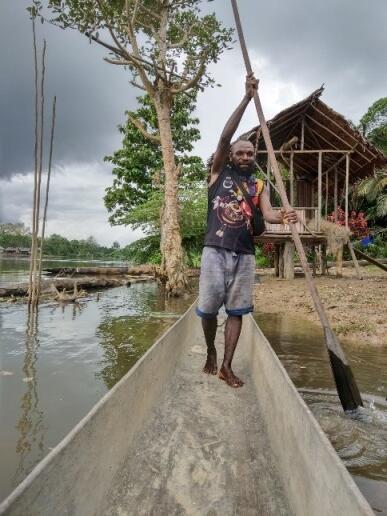Introducing the work of the Abau Project and Training Centre
Our local organisation refers to itself with different names. Sometimes we call ourselves Abau Training Centre (ATC) when we talk about courses and training. Sometimes we call ourselves simply Abau Project when the focus is on book production or academic work. Sometimes we use the combination: Abau Project & Training Centre. On this page you can read some basic information about where our work is, who our audience is and what we want to accomplish.
Where?
The Abau Project & Training Centre (abbreviated as ATC) has its home not far from the Sepik River in Sandaun Province. The nearest station with government services is Green River which has its own airstrip. The ATC is located in Yabru village. Out of Green River it is a 7-mile hike and canoe ride. Most of this trip can be done by canoe thanks to a man-made waterway.
The Abau Area is accessible from the coast by road. This road connection has been reliable in the last years, although one can never predict the state of the bridges. Transport by air is a reliable but an expensive option. The airstrip at the Green River Government Station is an all-weather airstrip and well maintained.

Who?
An estimated 20 000 Abau people live in villages along the Sepik River and its tributaries, starting at the East Sepik Province border all the way upstream till the border with the Indonesian West Papua (formerly called Irian Jaya). The Abau people live in a very swampy area and the villages along the Sepik River are completely flooded for a number of days of the year. Floods frequently destroy food gardens, but the availability of e.g. fish, sago and coconuts are not affected by the floods.
What?
The Abau Project seeks to raise the level of literacy among the Abau People, especially among children and women. Children are reached by means of a school curriculum in the Abau Language stressing cultural values. The Abau Project actively supports school the book production of a three year curriculum for community supported Abau schools. The program emphasizes the vernacular but especially in the third year English is taught as well.

When?
Work on Abau Language Analysis was started in 1982 by Arjen and Maija Lock who came under the auspices of SIL, Ukarumpa, EHP 444. The focus of SIL’s work is threefold: Translation, linguistic analysis, and literacy.
Academic Results
Examples of linguistic research:
the Abau phonology (2007) and Abau Grammar (printed in 2011), both available online. For the Abau Grammar: Arnold (Arjen) Hugo Lock. 2011. Abau Grammar. Data Papers on Papua New Guinea Languages, volume 57. Ukarumpa: SIL. xii + 483 pp.
Abau Phonology online: http://www.sil.org/pacific/png/show_work.asp?id=10147
Abau Grammar online: https://pnglanguages.sil.org/resources/archives/42179
Literacy achievements:
The development of the three year Abau curriculum. Since 1990, active literacy involvement in all Abau speaking villages. Project description and philosophy also available online as presented at a UNESCO language conference, Bangkok, July 2008: http://www.seameo.org/_ld2008/doucments/Presentation_document/ArjenLockBuildingResponsiveLifeEmbracing.pdf
Translation highlight:
The Abau New Testament was dedicated in October 2006. The Abau Text is available on this website under Menu item Reading Abau.
